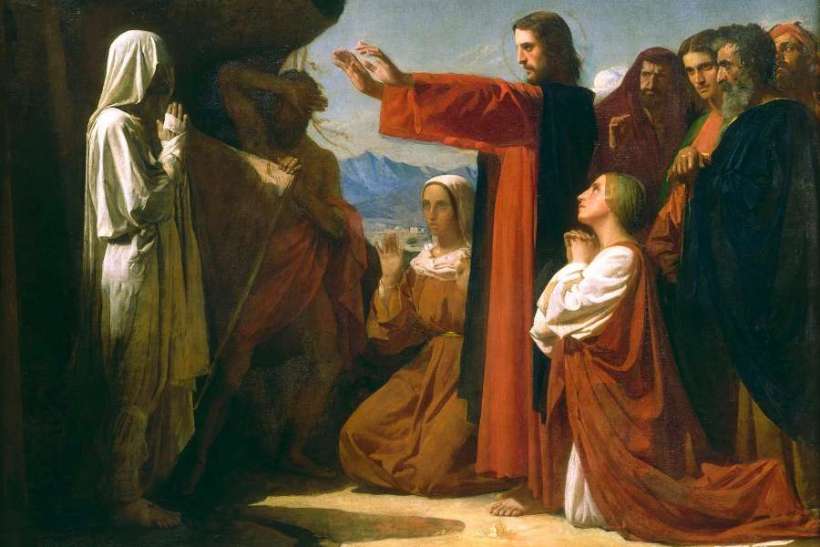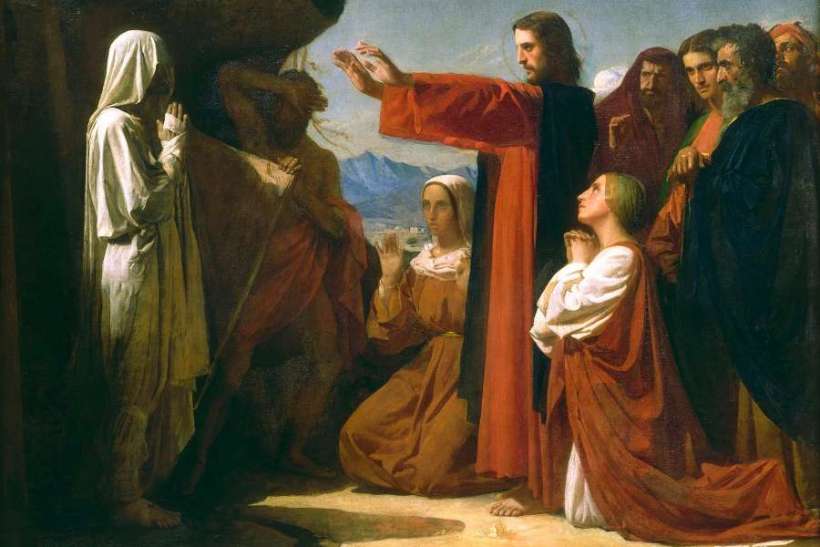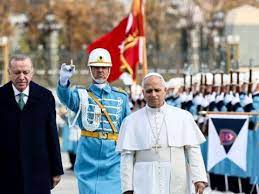Um decreto da Congregação para o Culto Divino dizia em 2 de fevereiro que o Papa Francisco incluiu os três santos no Calendário Romano Geral “considerando o importante testemunho evangélico que eles ofereceram ao acolher o Senhor Jesus em sua casa, ao ouvi-lo com atenção, em acreditando que ele é a ressurreição e a vida. ”
O Calendário Romano Geral é o calendário litúrgico da Igreja Católica, que denota as datas dos dias santos e das festas dos santos comemorados anualmente. O memorial de Santa Marta já estava incluído em 29 de janeiro no Calendário Romano Geral antes do Concílio Vaticano II, mas São Lázaro e Santa Maria foram originalmente deixados de lado devido à incerteza sobre a identidade de Maria Madalena.
O decreto explicava que essas incertezas “foram resolvidas em estudos e tempos recentes” e apontou que Maria e Lázaro já são comemorados em 29 de julho no Martirológio Romano, o catálogo oficial da Igreja de mártires e santos. Os santos Marta, Maria e Lázaro eram três irmãos que viviam na cidade de Betânia, fora de Jerusalém, durante a época de Cristo.
Assinado pelo cardeal Robert Sarah, prefeito da congregação do Culto Divino, o decreto do papa dizia que “na casa de Betânia o Senhor Jesus experimentou o espírito de família e a amizade de Marta, Maria e Lázaro e, por isso, o Evangelho de João afirma que os amava. ”
“Marta generosamente ofereceu-lhe hospitalidade, Maria ouviu atentamente suas palavras e Lázaro prontamente saiu do túmulo por ordem dAquele que humilhava a morte”, continua o decreto.
O correspondente da RECOWACERAO NEWS AGENCY, RECONA, concluiu que a festa de 29 de julho dos Santos Marta, Maria e Lázaro aparecerá agora nos calendários da Igreja e nos textos litúrgicos como um memorial. Esses memoriais ocupam o terceiro lugar na classificação dos dias de festa no calendário litúrgico da Igreja Católica. O memorial de Santa Marta, Maria e Lázaro será um memorial obrigatório, o que significa que deve ser observado.
O Papa Francisco também acrescentou três outros santos e Doutores da Igreja como memoriais opcionais no Calendário Romano Geral. De acordo com um decreto de 2 de fevereiro, São Hildegardo de Bingen será comemorado em 17 de setembro, São Gregório de Narek em 27 de fevereiro e São João de Ávila em 10 de maio.
“A combinação de santidade com conhecimento na experiência do mistério de Jesus Cristo está inextricavelmente ligada ao mistério da Igreja”, escreveu o cardeal Sarah no decreto.
“Esta ligação entre santidade e compreensão das coisas divinas e também humanas brilha de uma forma muito especial naqueles que receberam o título de‘ Doutor da Igreja ’”, disse ele.
“Com efeito, a sabedoria que caracteriza estes homens e mulheres não é só deles, pois, ao se tornarem discípulos da Sabedoria divina, eles próprios se tornaram mestres da sabedoria para toda a comunidade eclesial. É sob esta luz que os sagrados ‘Médicos’ estão inscritos no Calendário Romano Geral ”, explicou Sarah.
São Gregório de Narek foi um sacerdote, monge, místico e poeta do século 10, querido entre os cristãos armênios. Foi nomeado Doutor da Igreja pelo Papa Francisco em 2015. É venerado como santo tanto na Igreja Católica como na Igreja Apostólica Arménia, que não está em plena comunhão com Roma. Os Santos João de Ávila e Hildegarda de Bingen foram nomeados Doutores da Igreja pelo Papa Bento XVI em 2012.
“Doutor da Igreja” é um título dado a alguns santos em reconhecimento de sua extraordinária contribuição e importância universal para a Igreja Católica por meio de seus estudos e escritos. Atualmente, a Igreja concedeu este título a 36 santos. A partir do século 12, a alemã Santa Hildegarda foi uma abadessa beneditina, escritora, filósofa, mística cristã e visionária.
Ela também foi uma das mais conhecidas compositoras da monofonia sagrada, ou seja, canções com uma única melodia ou melodia, geralmente executada por uma única voz ou instrumento.
São João de Ávila viveu na Espanha nos anos 1500 e às vezes é chamado de “Apóstolo da Andaluzia” por causa de seu extenso ministério naquela região.
Ele era um sacerdote, autor e místico, e é conhecido por ter correspondido e influenciado santos espanhóis como Santa Teresa de Ávila, São João de Deus e Santo Inácio de Loyola.
Com a inserção de seus dias de festa no calendário romano geral como memoriais opcionais, os três santos podem agora ser comemorados na missa e outras liturgias.

Le correspondant officiel de RECOWACERAO NEWS AGENCY, RECONA attaché à la cité du Vatican, a rapporté que le pape François avait ajouté mardi dernier le mémorial des saints Marie, Marthe et Lazare au calendrier général romain, donnant aux frères et sœurs la fête combinée du 29 juillet. .
Un décret de la Congrégation pour le culte divin a déclaré le 2 février que le pape François avait inclus les trois saints dans le calendrier général romain «compte tenu de l’important témoignage évangélique qu’ils ont offert en accueillant le Seigneur Jésus dans leur maison, en l’écoutant attentivement, en croyant qu’il est la résurrection et la vie. »
Le calendrier général romain est le calendrier liturgique de l’Église catholique, qui indique les dates des jours saints et les jours de fête des saints commémorés chaque année. Le mémorial de Sainte-Marthe était déjà inclus le 29 janvier dans le calendrier général romain avant le Concile Vatican II, mais Saint-Lazare et Sainte-Marie avaient été initialement laissés de côté en raison de l’incertitude quant à l’identité de Marie-Madeleine.
Le décret expliquait que ces incertitudes «ont été résolues dans des études et des époques récentes» et soulignait que Marie et Lazare sont déjà commémorés le 29 juillet dans le Roman Martyrology, le catalogue officiel de l’Église des martyrs et des saints. Les saints Marthe, Marie et Lazare étaient trois frères et sœurs vivant dans la ville de Béthanie, à l’extérieur de Jérusalem, à l’époque du Christ.
Signé par le cardinal Robert Sarah, préfet de la congrégation du culte divin, le décret du pape disait que «dans la maison de Béthanie, le Seigneur Jésus a fait l’expérience de l’esprit de famille et de l’amitié de Marthe, Marie et Lazare, et pour cette raison, l’Évangile de Jean déclare qu’il les aimait.
«Marthe lui offrit généreusement l’hospitalité, Marie écouta attentivement ses paroles et Lazare sortit aussitôt du tombeau sous les ordres de Celui qui humiliait la mort», poursuit le décret.
Le correspondant de RECOWACERAO NEWS AGENCY, RECONA, a déclaré que la fête du 29 juillet des saints Marthe, Marie et Lazare apparaîtra désormais dans les calendriers et les textes liturgiques de l’Église comme un mémorial. Ces mémoriaux occupent la troisième place dans la classification des jours de fête dans le calendrier liturgique de l’Église catholique. Le mémorial de Sainte Marthe, Marie et Lazare sera un mémorial obligatoire, ce qui signifie qu’il doit être observé.
Le pape François a également ajouté trois autres saints et docteurs de l’Église comme mémoriaux facultatifs sur le calendrier général romain. Selon un décret du 2 février, sainte Hildegarde de Bingen sera commémorée le 17 septembre, saint Grégoire de Narek le 27 février et saint Jean d’Ávila le 10 mai.
«La combinaison de la sainteté et de la connaissance dans l’expérience du mystère de Jésus-Christ est inextricablement liée au mystère de l’Église», a écrit le cardinal Sarah dans le décret.
«Ce lien entre la sainteté et la compréhension des choses divines et aussi humaines brille d’une manière très spéciale chez ceux qui ont reçu le titre de« Docteur de l’Église »», a-t-il dit.
«En effet, la sagesse qui caractérise ces hommes et ces femmes n’est pas uniquement la leur, puisqu’en devenant disciples de la Sagesse divine, ils sont eux-mêmes devenus des maîtres de sagesse pour toute la communauté ecclésiale. C’est dans cette optique que les saints «docteurs» sont inscrits dans le calendrier général romain », a expliqué Sarah.
Saint Grégoire de Narek était un prêtre, moine, mystique et poète du Xe siècle aimé des chrétiens arméniens. Il a été nommé Docteur de l’Église par le Pape François en 2015. Il est vénéré comme saint à la fois dans l’Église catholique et dans l’Église apostolique arménienne, qui n’est pas en pleine communion avec Rome. Les saints Jean d’Ávila et Hildegarde de Bingen ont été nommés Docteurs de l’Église par le pape Benoît XVI en 2012.
«Docteur de l’Église» est un titre donné à certains saints en reconnaissance de leur contribution extraordinaire et de leur importance universelle à l’Église catholique à travers leurs connaissances et leurs écrits. Actuellement, l’Église a donné ce titre à 36 saints. À partir du 12ème siècle, la Sainte Hildegarde allemande était une abbesse bénédictine, écrivain, philosophe, mystique chrétien et visionnaire.
Elle était également l’un des compositeurs les plus connus de la monophonie sacrée, c’est-à-dire des chansons avec un seul air ou une seule mélodie, généralement interprétées par une seule voix ou un seul instrument.
Saint Jean d’Ávila a vécu en Espagne dans les années 1500 et est parfois appelé «l’apôtre d’Andalousie» en raison de son important ministère dans cette région.
Il était prêtre, auteur et mystique, et il est connu pour avoir correspondu et influencé des saints espagnols tels que Sainte Thérèse d’Avila, Saint Jean de Dieu et Saint Ignace de Loyola.
Avec l’insertion de leurs jours de fête dans le calendrier général romain en tant que mémoriaux facultatifs, les trois saints peuvent maintenant être commémorés à la messe et à d’autres liturgies.

The Official correspondent of RECOWACERAO NEWS AGENCY, RECONA attached to the city of Vatican has reported that Pope Francis, last Tuesday added the memorial of Saints Mary, Martha, and Lazarus to the General Roman Calendar, giving the siblings the combined feast day of July 29.
A decree from the Congregation for Divine Worship said on Feb. 2 that Pope Francis had included the three saints in the General Roman Calendar “considering the important evangelical witness they offered in welcoming the Lord Jesus into their home, in listening to him attentively, in believing that he is the resurrection and the life.”
The General Roman Calendar is the liturgical calendar of the Catholic Church, which denotes the dates of holy days and the feast days of saints commemorated annually. The memorial of St. Martha was already included on Jan. 29 in the General Roman Calendar before the Second Vatican Council, but St. Lazarus and St. Mary had been originally left off due to uncertainty about the identity of Mary Magdalene.
The decree explained that these uncertainties “have been resolved in recent studies and times,” and pointed out that Mary and Lazarus are already commemorated on July 29 in the Roman Martyrology, the Church’s official catalog of martyrs and saints. Saints Martha, Mary, and Lazarus were three siblings living in the town of Bethany outside of Jerusalem during the time of Christ.
Signed by Cardinal Robert Sarah, prefect of the Divine Worship congregation, the pope’s decree said that “in the household of Bethany the Lord Jesus experienced the family spirit and friendship of Martha, Mary, and Lazarus, and for this reason, the Gospel of John states that he loved them.”
“Martha generously offered him hospitality, Mary listened attentively to his words and Lazarus promptly emerged from the tomb at the command of the One who humiliated death,” the decree continued.
The correspondent of RECOWACERAO NEWS AGENCY, RECONA, gathered that the July 29 feast day of Saints Martha, Mary, and Lazarus will now appear in the Church’s calendars and liturgical texts as a memorial. These memorials rank third in the classification of feast days on the Catholic Church’s liturgical calendar. The memorial of Saint Martha, Mary, and Lazarus will be an obligatory memorial, which means it must be observed.
Pope Francis also added three other saints and Doctors of the Church as optional memorials on the General Roman Calendar. According to a Feb. 2 decree, St. Hildegard of Bingen will be commemorated on Sept. 17, St. Gregory of Narek on Feb. 27, and St. John of Ávila on May 10.
“The combination of holiness with knowledge in the experience of the mystery of Jesus Christ is inextricably linked to the mystery of the Church,” Cardinal Sarah wrote in the decree.
“This link between holiness and understanding things divine and also human shines out in a very special way in those who have been given the title ‘Doctor of the Church,’” he said.
“Indeed, the wisdom that characterizes these men and women is not solely theirs, since by becoming disciples of divine Wisdom they have themselves become teachers of wisdom for the entire ecclesial community. It is in this light that the holy ‘Doctors’ are inscribed in the General Roman Calendar,” Sarah explained.
St. Gregory of Narek was a 10th-century priest, monk, mystic, and poet beloved among Armenian Christians. He was named a Doctor of the Church by Pope Francis in 2015. He is venerated as a saint both in the Catholic Church and the Armenian Apostolic Church, which is not in full communion with Rome. Saints John of Ávila and Hildegard of Bingen was named Doctors of the Church by Pope Benedict XVI in 2012.
“Doctor of the Church” is a title given to some saints in recognition of their extraordinary contribution and universal importance to the Catholic Church through their learning and writings. At present, the Church has given this title to 36 saints. From the 12th century, the German St. Hildegard was a Benedictine abbess, writer, philosopher, Christian mystic, and visionary.
She was also one of the best-known composers of sacred monophony, meaning songs with a single tune or melody, usually performed by a single voice or instrument.
St. John of Ávila lived in Spain in the 1500s and is sometimes called the “Apostle of Andalusia” because of his extensive ministry to that area.
He was a priest, author, and mystic, and is known to have corresponded with, and influenced, Spanish saints such as St. Teresa of Avila, St. John of God, and St. Ignatius of Loyola.
With the insertion of their feast days in the General Roman Calendar as optional memorials, the three saints may now be commemorated at Mass and other liturgies.
- CATHOLIC ARCHBISHOP IN GHANA HAILS POPE LEO XIV AS GOD’S GIFT - 23 mai 2025
- POPE LEO XIV TO APPROVE CANONIZATIONS - 22 mai 2025
- THE EVOLUTION OF PAPAL TRANSPORTATION - 20 mai 2025







